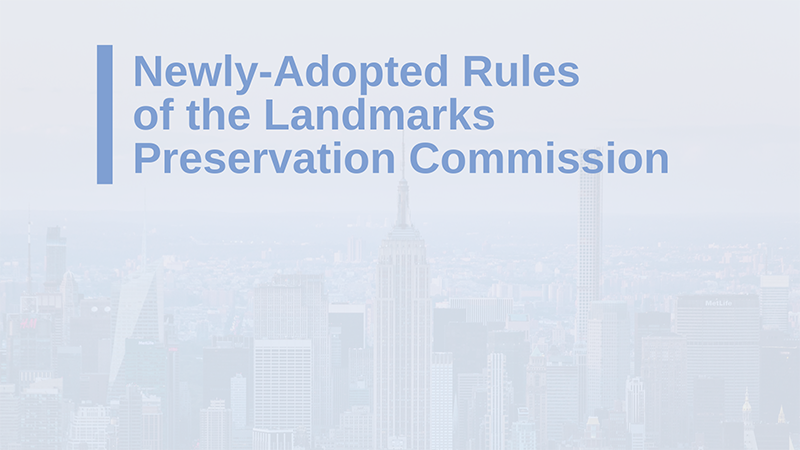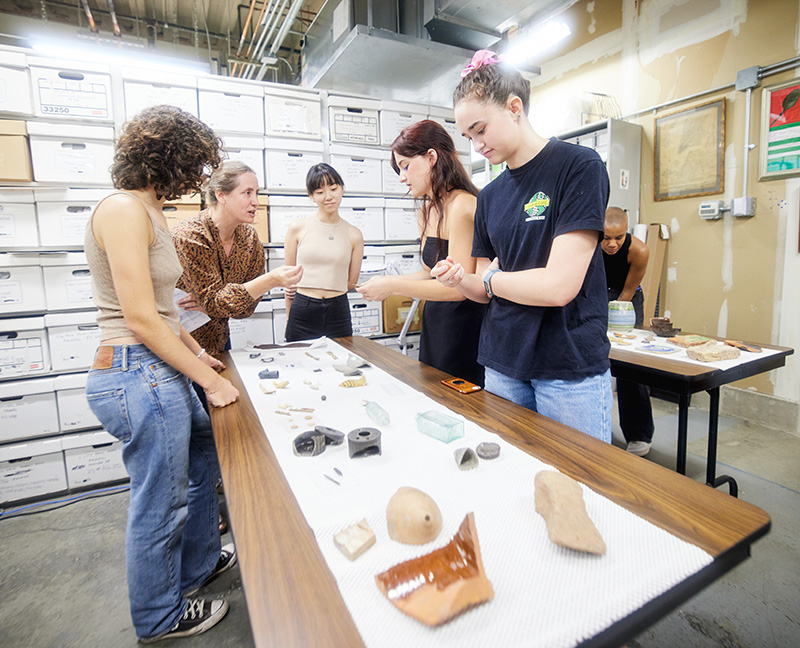|
NYC Landmarks Preservation Commission
|
LPC Approves New Rules Streamlining Agency Procedures to Support Businesses, Climate Resiliency and Sustainability Updates
|
|
|
|
|
 |
|
The application process is about to get a lot easier and faster for business owners and individual homeowners seeking LPC approval on a range of different types of permits, including building updates that would improve the climate resiliency and sustainability of landmarked properties.
On July 11th, the Commission voted to approve a series of new rules designed to streamline the application process by expanding the range of applications eligible for staff-level permits rather than requiring review by the full Commission at a public hearing.
For home and building owners, this will mean a more efficient application process across a range of sustainability and climate resiliency improvements, including a broader list of solar panel and energy-efficient HVAC unit upgrades – changes that will help advance the City’s new energy efficiency and climate resiliency codes and standards.
For business owners, the amendments will create a more flexible application process by codifying additional options for specific types of commercial signage and other provisions related to storefronts. It’s the latest in a series of recent agency initiatives designed to support New York City businesses, including LPC's Business Express Service, a one-stop shop with a dedicated agency team to make it easier for business owners in landmark buildings to apply for and receive the permits they need.
The new rules advance the Adams Administration’s “Get Stuff Built” initiative, and further LPC’s commitment to fairness, transparency, and efficiency as part of the Commission’s Equity Framework, which includes streamlined agency processes and increased access to resources for all applicants to help shorten application timelines and offer support to property owners through technical assistance and improved guidance.
More information about the amendments to LPC rules can be found on our website, or check out coverage of the changes in Crains New York, Commercial Observer, and City Land.
|
|
|
|
|
Three New Landmarks in the Bronx
|
|
|
|
|
|
|
|
|
The rich and vibrant heritage of the Bronx was on display on June 16th, as the Commission voted unanimously to designate three different sites across the borough as individual landmarks: the Bronx Opera House, Engine Company 88/ Ladder Company 38 Firehouse, and Fire Alarm Telegraph Bureau, Bronx Central Office.
All three sites were identified as part of a comprehensive borough-wide survey update of the Bronx conducted last year by a dedicated LPC research team.
LPC Chair Sarah Carroll hailed the designations, noting “These historic buildings tell the story of a time of transition and reinvention for both the Bronx and New York City as a whole, and reflect the Commission's ongoing commitment to ensuring that designations reflect the rich heritage of every borough."
- The Bronx Opera House was constructed in 1912-1913 and originally served as a stop on New York’s theatrical “Subway Circuit,” in which Broadway productions played the outer boroughs before heading out on tour, evolving in the 1950s as a major center of Latino/a culture and an important social gathering place for the rapidly growing Puerto Rican community in the South Bronx, with nightclubs that featured some of the biggest stars of the early Latin music and dance scene.
- Engine Company 88/ Ladder Company 38 Firehouse was constructed in 1908 to serve the growing population of the Belmont neighborhood, and its design reflects the changing needs of the increasingly professionalized New York City firefighting force established after the consolidation of the five boroughs in 1898.
- Fire Alarm Telegraph Bureau, Bronx Central Office , completed in 1915, is one of four borough offices constructed after the 5-borough consolidation, when the Fire Department of New York’s (FDNY) Manhattan-based fire alarm telegraph operations were no longer sufficient to handle the entire City’s needs. To improve response time, new central offices were established, including Fire Alarm Telegraph Bureau, Bronx Central Office, which could directly receive fire alarms and transmit the information to the appropriate firehouse.
You can read more about the three new Bronx landmarks on our website or see more the coverage on News12 Bronx, 6sqft, and Untapped New York.
|
|
|
|
|
Three Sites with Ties to Jazz History Designated as Individual Landmarks
|
|
|
|
|
|
|
|
|
LPC closed out the month of June with several more exciting designations, voting unanimously on June 27th to approve three new individual landmarks linked to significant people and venues that shaped the sound and trajectory of modern jazz.
- 935 St. Nicholas Avenue Building in Washington Heights, longtime home of two jazz pioneers, Edward Kennedy “Duke” Ellington and Noble Lee Sissle. Jazz pianist and composer Ellington lived in the building from 1939 to 1961 at the height of his prominent career, while noted ragtime jazz musician and music producer Sissle resided here from 1950 to 1972 during the later part of his career, when he remained a significant and influential figure in the performing arts and was considered the unofficial “mayor of Harlem.”
- The John Birks “Dizzy” Gillespie Residence in Corona, Queens, home to the legendary jazz trumpeter, composer, and bandleader at the height of his career, his basement rehearsal studio here became a center for Corona’s jazz community.
- Harlem’s Hotel Cecil & Minton’s Playhouse Building, where performances at the famous nightclub attracted some of the biggest jazz innovators of the time and are credited with helping launch the pivotal jazz style called “bebop,” transforming the direction of American music.
All three were identified as part of a citywide Commission survey of sites associated with significant Black history, and their designations further the goals of LPC’s Equity Framework as the Commission continues prioritize designations that represent New York City’s diversity.
“The story of Jazz is also the story of the Black community, who built tight-knit communities and cultural institutions in the face of racial discrimination,“ noted LPC Chair Sarah Carroll in announcing the designations. “I’m proud that the Commission has chosen to honor this history and thrilled that these landmarks will be preserved for future generations to come.”
More information on NYC’s newest individual landmarks can be found here or as part of the coverage of the designations on PIX11 and Harlem World.
|
|
|
|
|
Bard Graduate Center’s Summer Program Students Visit the NYC Archaeology Repository
|
|
|
|
|
 |
|
On July 12th, LPC was thrilled to welcome students from Bard Graduate Center’s Summer Program for Undergraduates on their visit to the NYC Archaeology Repository: The Nan A. Rothschild Research Center. Dr. Jessica Striebel MacLean, an urban archaeologist from LPC’s Archaeology Department, led the special guests on a detailed tour in which students got a close-up look at the Repository’s collection and important work preserving the City’s archaeological resources.
The Repository opened in 2014 as a project of LPC’s Archaeology Department, curating the city’s archaeological collections and making them accessible for archaeologists, researchers, teachers, students, and the public. The Repository currently houses hundreds of thousands of artifacts from over 32 sites throughout the city and is open by appointment to researchers and scholars.
Many thanks to the Bard Graduate Center for a great visit – and the opportunity to share our passion for uncovering New York City’s archaeological history with the next generation of scholars!
Click here for more information about the New York City Archaeological Repository, including highlights from the City’s collections.
|
|
|
|
|
Remembering Former LPC Chair and Commissioner Beverly Moss Spatt
|
|
We were saddened to hear of the passing of former LPC Chair and Commissioner, Beverly Moss Spatt. A former City Planning Commissioner, Commissioner Moss Spatt was appointed by Mayor Beame and served as Chair of LPC from 1974-1978, remaining on the Commission until 1982. Commissioner Spatt navigated LPC through a period of great change in the City’s history, with a new agency, a new law and powers, and a burgeoning field of historic preservation.
In the 1970s, as the City faced a major fiscal crisis, the Landmarks Law was tested in the nation’s highest court when the Supreme Court upheld the law and recognized historic preservation as a legitimate public purpose. In addition, Local Law No. 71 expanded the Commission’s mandate to include the designation of interior landmarks and scenic landmarks.
Under Commissioner Moss Spatt, LPC designated landmarks and historic districts throughout the five boroughs in the 1970s. Designations embraced an increasing variety of building types, historical periods, and styles, as well as recognizing sites with cultural significance. In 1974, Central Park became the City’s first scenic landmark, and interiors of the New York Public Library became the first interior landmark. Under Commissioner Moss Spatt’s leadership, LPC also designated its first public school (Boys’ High School in Brooklyn, 1975) and public housing complex (First Houses in 1974 and Harlem River Houses in 1975), and its first Modern landmark (the William Lescaze House) in 1976.
Across a lifetime of dedication to the field of preservation, Commissioner Moss Spatt left an indelible mark on the Landmarks Preservation Commission, and on New York City as a whole.
|
|
|
|
|
This is the NYC.gov news you requested for:
Landmarks Preservation Commission News
Unsubscribe | Preferences | Comments
PLEASE DO NOT REPLY TO THIS MESSAGE!
|
|
|
|